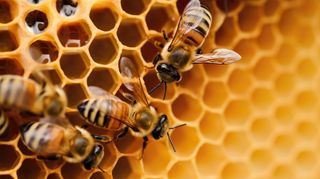Does honey ever go bad?

Honey is a pantry staple that can be safe to eat for ages. But does honey ever go bad? And why is honey so resistant to spoiling?
It appears that this thick, sticky, sweet nectar owes its properties to chemicals imparted by its makers — honeybees. Astonishingly, there are at least 300 types of honey known today that are produced by more than 20,000 honeybee species.
"The composition of the honey depends on the type of honeybees," Kantha Shelke, a food scientist at Johns Hopkins University and founder of Corvus Blue LLC, a food science and nutrition research firm based in Chicago, told Live Science in an email.
After collecting nectar from flowers, bees turn the sucrose, a complex mix of glucose and fructose, into highly concentrated simple sugars. While honey is mostly sugars, it also contains more than a dozen other substances, such as enzymes, minerals, vitamins and organic acids. Honey also contains flavonoid and phenolic compounds, which are known to be anti-inflammatory and antioxidants. These compounds are responsible for honey's medicinal properties.
The multitude of chemicals that coalesce when honeybees create honey makes this natural sweetener inhospitable to microbes that usually spoil food.
Honey's high sugar content makes it hygroscopic, meaning it can suck moisture from the environment, and even absorb the water from surrounding microbial cells. Honey also has a low level of available water in which microbes can grow.
After turning flower nectar into simple sugars, bees regurgitate the sweet liquid and pass it on to other bees in the hive. As the nectar sits inside the bees' stomachs, glucose oxidase breaks down the glucose and turns it into gluconic acid and hydrogen peroxide. When the bees finally place and fan the digested nectar in the comb, water slowly evaporates and turns this sweet liquid viscous.
The presence of gluconic, as well as acetic, formic, and citric acid, makes honey even more acidic than coffee. This pH range is lower than what most microbes can tolerate. And the hydrogen peroxide in honey may stop bacteria from forming a slimy network called biofilm that usually sticks to surfaces.
All of these chemicals stop microbes from degrading honey. But while honey remains safe to consume for a long period, it does change over time.
"Honey constituents undergo changes because of crystallization, fermentation, oxidation, and thermal effects. The changes also depend on the type of honey (light or dark) and source, or region which vary with the season and the plants foraged by the honeybee," Shelke said. "Some of these changes influence the nutritional and sensory attributes including appearance."

When heated or stored for a long time, honey can undergo a Maillard reaction, the same chemical reaction that caramelizes sugar and turns it brown. As sugars become dehydrated, they produce a potentially toxic compound, 5-hydroxymethylfurfural (HMF). HMF is also found in many other food products including breakfast cereals, dried fruits and milk.
The safe levels of HMF for daily consumption are still poorly understood. Some research has suggested HMF can fuel cancer, while others suggest the compound can prevent allergic reactions. The Codex Alimentarius Standard, an international standard on food safety, has set an upper limit of 40 mg/kg HMF for honey products. But this limit varies among the different types of honey. For instance, sunflower honey can reach this HMF limit after being properly stored for 18 months, while acacia honey takes about five years to reach the same amount of HMF.
Heating leads to HMF production, but cooling causes honey to crystallize. As honey cools, the sugar content becomes too saturated and unable to stay in solution. This can also happen when moisture escapes the honey during storage, causing the sugars to form crystals, Shelke said.
According to one study, the sensory and chemical properties of honey are best preserved when stored at 75 degrees Fahrenheit (24 degrees Celsius), or around room temperature.
Because of all these variables, "handling and packaging can greatly affect the shelf life of honey," Shelke said. "Raw honey — with intact enzymes and other beneficial compounds — is minimally processed and can last 'forever' if stored in a sealed container."
Likewise, pasteurized honey can last several years. But because it lacks some of the enzymes and antimicrobial compounds, it may be susceptible to microbial damage if not sealed or stored properly, Shelke added.
Of note, caretakers should avoid feeding honey to infants, because spores from the bacterium Clostridium botulinum can contaminate honey. These spores can withstand pasteurization temperatures. Once ingested, they can release a toxin into babies' intestines and cause infant botulism, a condition that can be fatal. The spores are generally harmless to adults as their mature digestive systems purge the toxin.